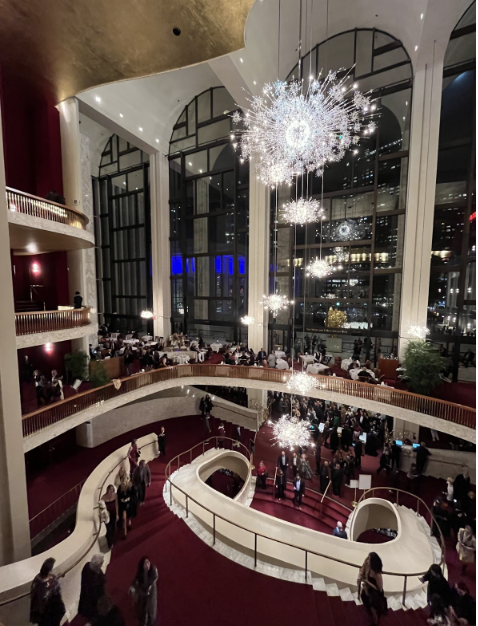SPPAC Attends Tosca at the Met Opera House
January 25, 2023
On November 4th, the Saint Peter’s Prep Performing Arts Club (SPPAC) went to the Metropolitan Opera House in Manhattan to watch a world-class rendition of Tosca, the 1899 opera written by Italian composer Giacomo Puccini.
For over a century, Tosca at the Met has entertained and bedazzled both novices and experienced opera attendees alike—and the members of SPPAC were no different. Chaperoned by Fr. John Mullin and Ms. Trish Fitzpatrick, SPPAC gathered at 5:00 p.m. for dinner. Pasta, chicken parmesan, salad, and cookies were served alongside other refreshments. After dining and being given a synopsis of the opera by Fr. Mullin, SPPAC members waited outside the school for their ride: a yellow school bus. At 6:30 p.m., the school bus arrived, and SPPAC set off for the city.
After a longer-than-expected ride due to traffic, SPPAC arrived at the Metropolitan Opera for the 8:00 p.m. show. A pulchritudinous display of American architectural design, the Met dazzled and dropped the jaws of the attending SPPAC members: “It was absolutely breathtaking,” opined one spectator. “I’ve never seen anything like it—the chandeliers, the fanciness; everything was amazing.” After some gazing around, the members of SPPAC were escorted to their seats by many kind and attentive ushers. Shortly after taking their seats, the orchestra tuned their instruments and started the show.
The opera, which is set in Italy during the Napoleonic Wars, revolves around Floria Tosca, the main protagonist, and Mario Cavaradossi, Tosca’s boyfriend and a sympathizer of the former Roman Republic. Cesare Angelotti, a former consul of the Roman Empire and a friend of Cavaradossi, escapes from prison and goes to him for help. Cavaradossi quickly assists him, bringing Angelotti to his cottage out of town. Shortly after they leave, Baron Scarpia, the chief of police, arrives and looks for Angelotti. Upon seeing Tosca, who had just heard her boyfriend talking to Angelotti and mistakenly assumed was another woman, Scarpia sparks her jealousy and successfully persuades her to go confront Cavaradossi. When Tosca does so, Scarpia orders his officers to follow her and hunt down Angelotti and Cavaradossi.
In the second act, Scarpia asks Tosca to meet him at his apartment; unbeknownst to Tosca, Scarpia’s men had already tracked down and arrested Cavaradossi. When Tosca arrives, she sees Scarpia’s men dragging a beat-up Cavaradossi into a torture chamber, who yells to Tosca to not tell Scarpia anything. Scarpia, however, orders his men to intentionally use certain torture tactics on Cavaradossi to make him scream in pain, agonizing Tosca. Despite Cavaradossi’s plead, Tosca eventually breaks, telling Scarpia the whereabouts of Angelotti in order to save her boyfriend. Scarpia orders his men to cease torturing Cavaradossi, yet when he is dragged out of the torture chamber and hears news of Napoleon’s advancement into Rome, he gloats that Scarpia’s reign of terror will soon end. Scarpia, angered by this remark, calls for Cavaradossi’s execution. Once Cavaradossi and Scarpia’s men leave the room, Scarpia makes a proposition to Tosca: if she agrees to let him bed her, Scarpia will spare Cavaradossi’s life. After much pondering and grieving, which included Tosca singing “Vissi d’arte”, the opera’s most well-known aria, Tosca agrees to do so, ordering Scarpia to write his pardon first. As soon as Scarpia does so and advances towards Tosca, she stabs and kills him before leaving to find and save Cavaradossi.
In the final act of the opera, Cavaradossi is stationed on the roof of a castle, awaiting execution. He bribes one of the guards to let him write a final goodbye to Tosca, painfully stating in an aria that he wishes he could have spent the rest of his life with her. As he tries to comfort himself in the face of death, Tosca arrives, telling him of Scarpia’s pardon and that he will need to partake in a fake execution before they can escape. As they joyfully embrace and reconnect, the duo sings of the happiness and brightness of their future together. When the firing squad comes to perform the fake execution, Tosca tells Cavaradossi to fall after the squad fires their blanks, before moving to the side of the roof to watch. Cavaradossi does as he is told; he falls as soon as the squad fires their muskets. As the firing squad clears out, Tosca goes up to Cavaradossi, who is still lying down, and tells him that the fake execution is over and that he can now stand up. Upon close inspection, however, she sees blood all over his shirt; the firing squad had shot Cavaradossi with real rounds. As Tosca cries in agony, one of Scarpia’s men bursts down the door next to her and declares her arrest. Tosca quickly runs to the edge of the roof and screams “O Scarpia, avanti a Dio!”, translated in English to “O Scarpia, we meet before God!” before jumping off to her death.
The opera itself was stunning: Tosca exceeded many of the SPPAC members’ expectations. The performances by the show’s cast, especially that of Aleksandra Kurzak, the performer of the titular character, were simply stunning; the polished and grandiose manner of the program would be enough to awe even the most devoted opera enthusiasts. Kurzak’s rendition of the opera’s most well-known aria, “Vissi d’arte”, was powerful enough to send shivers down one’s spine. “Everything about it was amazing,” stated an SPPAC member. “Going into [Tosca], I thought it would boring…[but] it was incredible.”


